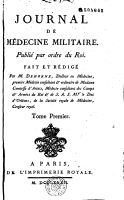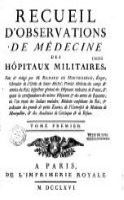
[ No 7 ]

TEXT MINING
TALLAHASSEE
15 MARCH 2021
Texts
Reference: I selected military medical journals published in the mid to late 18th century to serve as my reference body of texts. The first of these jounrals,Journal de medecine militaire first published in 1781, was the brainchild of Jacques de Horne, a miltiary doctor who also served as physician to members of the royal family. The second journal published in 1766 and entitled Recueil d’observations de médecine des hôpitaux militaires was edited by Richard de Hauterierck, who served as the head doctor for French armies.
Primary: For my primary texts, from these journals I selected individual artcles on medical topography. Medical topography was an in-vogue topic for early modern medical practitioners. At the time, Hippocrates’ theories about the environment’s impact on human health dictated that doctors and surgeons intimately understand the local climates in which they worked. They also needed to know how things like water quality, elevation change, seasonal shifts, soil quality and local foods could make people sick or keep them healthy. Producing articles on medical topography was a great way for the military to keep track of the local climates in which particualr hopsitals were located.


Results
Reference On my first attempt, the topic modeling produced mostly lists of stop words. Burried with these stop words are some of the most common illnesses and conditions that military medical practitioners in the 18th century were concerned with, such as fevers, inflamation, small pox aka “petite vérole.” See Image 1. After I downloaded a list of stop words, the modeling worked much better. Here it yeilded words that you might expect. Hospital, fever, observations, wounds, blood and more. See Image 2.
Primary This section produced better results. We can see some of the general geographic features the military physicians were interested in, such as rivers, montains, swamps, hills and more. There are also references to sunlight, vapors, seasons, cities and others. These findings are not surprising. Doctors were trained to look at factors such as these we describing the salubrity of a given area. See Image 3.
Conclusions
Results here were unsurprising. The reference texts were much more general, while the topographic texts turned up topics related to geography, climate, and demographics. Of final note, I was unable to decipher any specific topics from the topic modeling. The topics generated felt like an undifferentiated mass of words, much closer to Voyants “bag of words” approach than what I had thought would be stand alone topics.
by
.png)
.png)
.png)